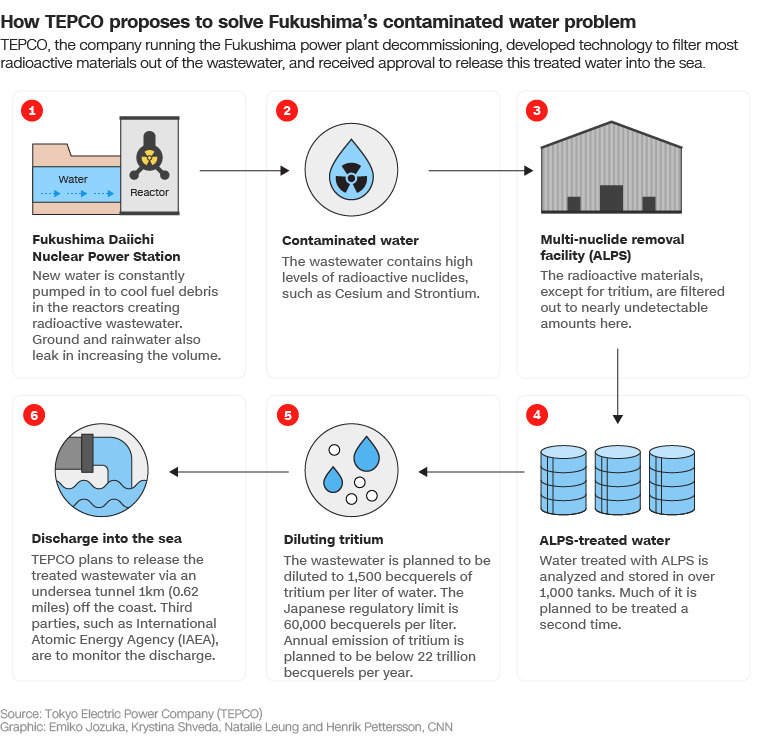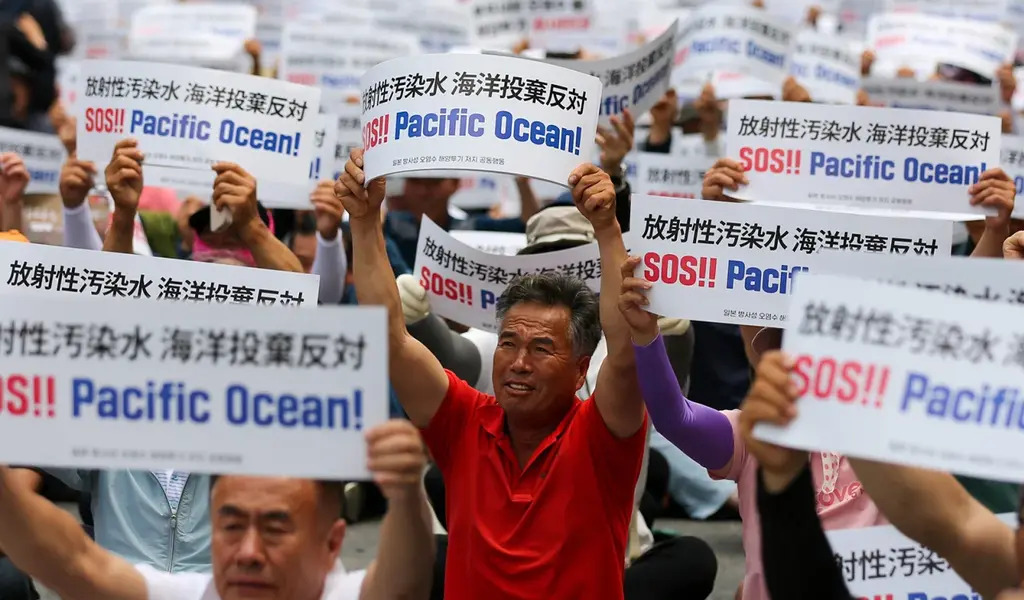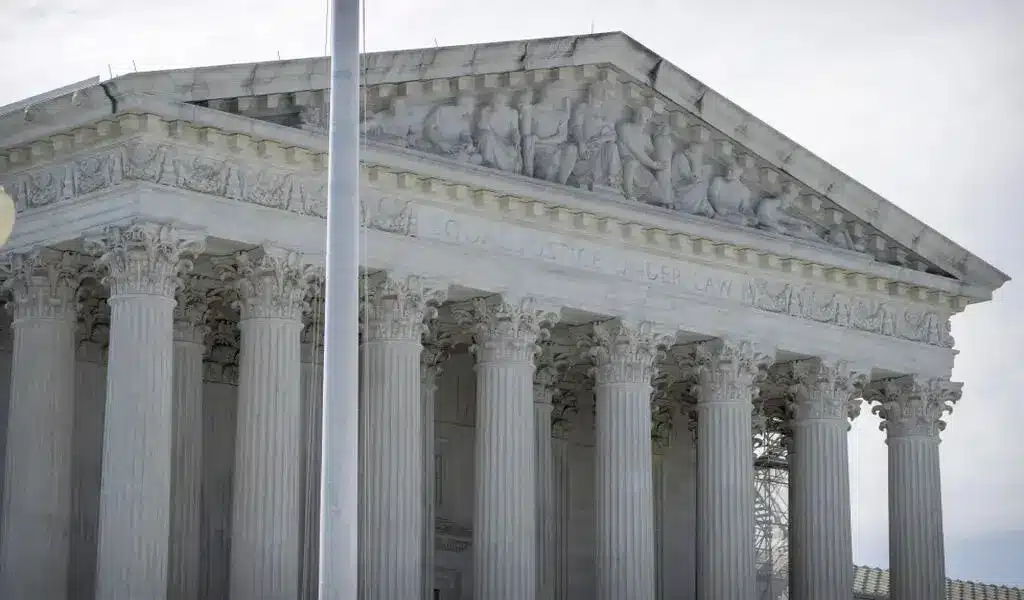News
Japan To Begin Release Of Treated Radioactive Water Into Ocean Following UN Approval
(CTN NEWS) – Following approval from the United Nations’ nuclear watchdog, Japan is set to commence the release of treated radioactive water into the ocean, marking a significant step in a controversial plan that comes 12 years after the Fukushima nuclear meltdown.
The decision to release the treated wastewater has been in progress for several years, prompted by the depletion of available space to contain the contaminated material, as declared by the environment minister in 2019.
Rafael Grossi, the head of the International Atomic Energy Agency (IAEA), arrived in Japan on Tuesday to visit the Fukushima site and present the UN body’s safety review to Prime Minister Fumio Kishida.
However, despite the UN’s approval, neighboring countries’ concerned residents and local fishermen, who continue to experience the repercussions of the 2011 disaster, remain uneasy and unconvinced.
There are doubts cast upon the findings of the IAEA, with China recently expressing that the group’s assessment “does not serve as proof of the legality and legitimacy” of releasing Fukushima’s wastewater.
Here’s the essential information you should know:
Why is this happening?
In 2011, a severe earthquake and tsunami struck, leading to significant damage to the power supply and cooling systems of the Fukushima nuclear plant.
This resulted in the overheating of the reactor cores and the contamination of water within the plant with highly radioactive substances.
To prevent further incidents, fresh water has been continuously pumped into the reactors to cool the fuel debris.
However, in the process, groundwater and rainwater have also seeped into the plant, further increasing the volume of radioactive wastewater that needs to be managed and treated.

The state-owned electricity company Tokyo Electric Power Company (TEPCO) has constructed over 1,000 large tanks to store the current volume of 1.32 million metric tons of wastewater, equivalent to filling over 500 Olympic-sized pools.
However, available space is rapidly diminishing. TEPCO states that constructing additional tanks is not a viable option and that it is necessary to create space in order to safely decommission the plant.
This decommissioning process involves decontaminating facilities, dismantling structures, and completely shutting down operations.
What are the potential risks?
According to TEPCO, the radioactive wastewater can have hazardous elements, but a significant portion of these elements can be removed from the water through treatment processes.
The primary concern lies with a hydrogen isotope called radioactive tritium, which cannot be effectively eliminated using current technologies.
As a result, the plan is to dilute the contaminated water significantly and release it gradually over a span of many years, as emphasized by Japan’s government and the IAEA.
They assert that the concentration of tritium in the released water would be comparable to or even lower than the permissible levels allowed by other countries, meeting international safety and environmental regulations.
They also argue that tritium is naturally present in the environment, found in rainwater, seawater, tap water, and even within the human body, suggesting that releasing small quantities into the ocean should pose no significant harm.
In the IAEA report, Rafael Grossi stated that the discharge of treated water into the sea would have a “negligible radiological impact on people and the environment.”
However, experts hold differing opinions regarding the potential risks associated with this course of action.
The Canadian Nuclear Safety Commission explains that tritium itself is not capable of penetrating the skin, but consuming it in “extremely large quantities” can increase the risk of cancer.
Similarly, the US Nuclear Regulatory Commission acknowledges that any exposure to radiation carries some health risk, but emphasizes that small amounts of tritium are encountered by individuals on a daily basis.
A group of international scientists, including Robert H. Richmond, director of the Kewalo Marine Laboratory at the University of Hawaii at Manoa, is collaborating with the Pacific Island Forum to evaluate the plan for releasing wastewater.
This involves visits to the Fukushima site and meetings with TEPCO, Japanese authorities, and the IAEA. After examining the plan’s details, Richmond criticized it as “ill-advised” and premature.
One concern is that diluting the wastewater may not be sufficient to minimize its impact on marine life.
Richmond explains that pollutants like tritium can traverse various levels of the food chain, including plants, animals, and bacteria, leading to “bioaccumulation” where they accumulate within the marine ecosystem.
Moreover, Richmond highlights that the world’s oceans are already facing significant stress due to climate change, ocean acidification, overfishing, and pollution.
Treating them as a “dumping ground” would exacerbate these challenges, he warns.
The potential risks associated with the wastewater release extend beyond the Asia-Pacific region.
A study conducted in 2012 found evidence that bluefin tuna had transported radionuclides, similar to those found in nuclear wastewater, from Fukushima across the Pacific to California.
Process Of Releasing The Water

The process of releasing the water involves several steps. Initially, the wastewater undergoes treatment to remove as many of the harmful elements as possible.
Following treatment, the water is stored in tanks and subjected to analysis to determine the remaining radioactive levels. A significant portion of the water will undergo a secondary treatment process, as outlined by TEPCO.
Once the necessary treatments have been completed, the wastewater will be diluted to a concentration of 1,500 becquerels of tritium, which is a unit used to measure radioactivity, per liter of clean water.
This dilution process aims to reduce the concentration of tritium before releasing the water into the environment.
For comparison, Japan’s regulatory limit permits a maximum of 60,000 becquerels per liter for tritium in water.
‘The World Health Organization allows up to 10,000 becquerels per liter, while the United States has a more stringent limit of 740 becquerels per liter.
Following the dilution process, the water will be released into the Pacific Ocean via an undersea tunnel located off the coast.
To ensure transparency and compliance with international safety standards, third-party organizations such as the International Atomic Energy Agency (IAEA) will monitor the discharge throughout and after the release.
Rafael Grossi, in the report, stated that this monitoring would ensure the consistent application of relevant international safety standards as outlined by the government of Japan and TEPCO over the course of several decades.
What have other countries said?
The plan has evoked mixed reactions, with both support and skepticism coming from various quarters.
The United States has expressed support for Japan’s decision, with the State Department stating in a 2021 statement that Japan has been transparent in its decision-making process and appears to be adhering to globally accepted nuclear safety standards.
Taiwan’s Atomic Energy Council has indicated that the amount of tritium being released is estimated to be below the detection limit, resulting in minimal impact on Taiwan. The island is situated southwest of Japan.
However, there is greater resistance from Japan’s neighboring countries.
In March, a high-ranking Chinese official expressed concerns about the potential unpredictable harm to the marine environment and human health resulting from the release of the wastewater.
The official emphasized that the Pacific Ocean should not serve as Japan’s disposal site for discharging its nuclear-contaminated water.
The Secretary General of the Pacific Islands Forum, an inter-governmental organization comprising Pacific islands including Australia and New Zealand, also voiced serious concerns in a January op-ed.
He emphasized the need for more data before allowing any ocean release, emphasizing the responsibility to secure a safe and protected future for the coming generations.
In June, South Korean Prime Minister Han Duck-soo expressed support for the plan, even stating that he would be willing to drink the treated wastewater meeting international standards.
However, this statement was met with ridicule by the opposition leader in South Korea.

Do other countries release wastewater as well?
Numerous organizations, including the IAEA, highlight that nuclear power plants worldwide regularly and safely release treated wastewater that contains low levels of tritium.
A spokesperson from the Nuclear Regulatory Commission, a government agency in the United States, confirmed to CNN that nearly all nuclear plants in the country release water with low levels of radioactivity into the waterways where they are situated.
The spokesperson further explained that tritium, although it cannot be filtered out, would require a significant ingestion amount by an individual to even consider the possibility of a health concern.
They emphasized that the radioactive water released into the waterway is extensively diluted by natural flows.
Despite these statements, many scientists remain unconvinced.
Tim Mousseau, a professor of biological sciences at the University of South Carolina, highlighted the lack of sufficient research into the environmental and food-related impacts of tritium, regardless of its common practice among nuclear plants.
Adding to the concerns, Richmond from the University of Hawaii emphasized that the actions of other entities should not serve as an excuse to continue releasing wastewater into the ocean.
He viewed this situation as an opportunity for Japan and the IAEA to alter the prevailing practices for the better.
How does the public perceive the situation?
Residents in the region have expressed significant skepticism, leading some shoppers to take precautions by stocking up on seafood and sea salt, fearing that these products may be affected by the release of wastewater.
In South Korea, there has been a notable increase in sea salt prices, with store owners reporting that their sales have recently doubled, as reported by Reuters.
A viral tweet in Korean claimed to have purchased a three-year supply of seaweed, anchovies, and salt, reflecting the concern among individuals.
According to Reuters, the Korean fisheries authority has announced its intention to intensify monitoring of salt farms for any signs of radioactivity.
Additionally, they will uphold the existing ban on seafood originating from waters near Fukushima.
In response to the plan, members of the Korean public have staged protests, some even wearing gas masks, outside the Japanese embassy in Seoul, as a means of expressing their opposition.
Opinions within the Japanese public are also divided on the issue. A survey conducted by Asahi Shimbun in March revealed that among 1,304 respondents, 51% supported the release of wastewater, while 41% opposed it.
Earlier this year, residents in Tokyo, the capital, took to the streets to protest against the plan.
In Fukushima, the prefecture where the nuclear disaster occurred, local fishermen have been steadfastly against the plan since its inception.
Following the meltdown, fishing operations were suspended for many years, and other countries imposed import restrictions.
Even after the surrounding water and fish returned to safe levels, consumer confidence was never fully restored. Consequently, Fukushima’s fishing industry now represents only a fraction of its former value.
Critics argue that the release of wastewater could inflict further damage on Fukushima’s global and regional reputation, thereby negatively impacting the livelihoods of fishermen.
Earlier this year, one fisherman expressed frustration, stating, “It really feels like they made this decision without our full consent.”

News
Google’s Search Dominance Is Unwinding, But Still Accounting 48% Search Revenue

Google is so closely associated with its key product that its name is a verb that signifies “search.” However, Google’s dominance in that sector is dwindling.
According to eMarketer, Google will lose control of the US search industry for the first time in decades next year.
Google will remain the dominant search player, accounting for 48% of American search advertising revenue. And, remarkably, Google is still increasing its sales in the field, despite being the dominating player in search since the early days of the George W. Bush administration. However, Amazon is growing at a quicker rate.
Google’s Search Dominance Is Unwinding
Amazon will hold over a quarter of US search ad dollars next year, rising to 27% by 2026, while Google will fall even more, according to eMarketer.
The Wall Street Journal was first to report on the forecast.
Lest you think you’ll have to switch to Bing or Yahoo, this isn’t the end of Google or anything really near.
Google is the fourth-most valued public firm in the world. Its market worth is $2.1 trillion, trailing just Apple, Microsoft, and the AI chip darling Nvidia. It also maintains its dominance in other industries, such as display advertisements, where it dominates alongside Facebook’s parent firm Meta, and video ads on YouTube.
To put those “other” firms in context, each is worth more than Delta Air Lines’ total market value. So, yeah, Google is not going anywhere.
Nonetheless, Google faces numerous dangers to its operations, particularly from antitrust regulators.
On Monday, a federal judge in San Francisco ruled that Google must open up its Google Play Store to competitors, dealing a significant blow to the firm in its long-running battle with Fortnite creator Epic Games. Google announced that it would appeal the verdict.
In August, a federal judge ruled that Google has an illegal monopoly on search. That verdict could lead to the dissolution of the company’s search operation. Another antitrust lawsuit filed last month accuses Google of abusing its dominance in the online advertising business.
Meanwhile, European regulators have compelled Google to follow tough new standards, which have resulted in multiple $1 billion-plus fines.

Pixa Bay
Google’s Search Dominance Is Unwinding
On top of that, the marketplace is becoming more difficult on its own.
TikTok, the fastest-growing social network, is expanding into the search market. And Amazon has accomplished something few other digital titans have done to date: it has established a habit.
When you want to buy anything, you usually go to Amazon, not Google. Amazon then buys adverts to push companies’ products to the top of your search results, increasing sales and earning Amazon a greater portion of the revenue. According to eMarketer, it is expected to generate $27.8 billion in search revenue in the United States next year, trailing only Google’s $62.9 billion total.
And then there’s AI, the technology that (supposedly) will change everything.
Why search in stilted language for “kendall jenner why bad bunny breakup” or “police moving violation driver rights no stop sign” when you can just ask OpenAI’s ChatGPT, “What’s going on with Kendall Jenner and Bad Bunny?” in “I need help fighting a moving violation involving a stop sign that wasn’t visible.” Google is working on exactly this technology with its Gemini product, but its success is far from guaranteed, especially with Apple collaborating with OpenAI and other businesses rapidly joining the market.
A Google spokeswoman referred to a blog post from last week in which the company unveiled ads in its AI overviews (the AI-generated text that appears at the top of search results). It’s Google’s way of expressing its ability to profit on a changing marketplace while retaining its business, even as its consumers steadily transition to ask-and-answer AI and away from search.

Google has long used a single catchphrase to defend itself against opponents who claim it is a monopoly abusing its power: competition is only a click away. Until recently, that seemed comically obtuse. Really? We are going to switch to Bing? Or Duck Duck Go? Give me a break.
But today, it feels more like reality.
Google is in no danger of disappearing. However, every highly dominating company faces some type of reckoning over time. GE, a Dow mainstay for more than a century, was broken up last year and is now a shell of its previous dominance. Sears declared bankruptcy in 2022 and is virtually out of business. US Steel, long the foundation of American manufacturing, is attempting to sell itself to a Japanese corporation.
SOURCE | CNN
News
2024 | Supreme Court Won’t Hear Appeal From Elon Musk’s X Platform Over Warrant In Trump Case

Washington — Trump Media, The Supreme Court announced Monday that it will not hear an appeal from social media platform X about a search warrant acquired by prosecutors in the election meddling case against former President Donald Trump.
The justices did not explain their rationale, and there were no recorded dissents.
The firm, which was known as Twitter before being purchased by billionaire Elon Musk, claims a nondisclosure order that prevented it from informing Trump about the warrant obtained by special counsel Jack Smith’s team violated its First Amendment rights.
The business also claims Trump should have had an opportunity to exercise executive privilege. If not reined in, the government may employ similar tactics to intercept additional privileged communications, their lawyers contended.
Supreme Court Won’t Hear Appeal From Elon Musk’s X Platform Over Warrant In Trump Case
Two neutral electronic privacy groups also joined in, urging the high court to hear the case on First Amendment grounds.
Prosecutors, however, claim that the corporation never shown that Trump utilized the account for official purposes, therefore executive privilege is not a problem. A lower court also determined that informing Trump could have compromised the current probe.

Trump utilized his Twitter account in the weeks preceding up to his supporters’ attack on the Capitol on January 6, 2021, to spread false assertions about the election, which prosecutors claim were intended to create doubt in the democratic process.
The indictment describes how Trump used his Twitter account to encourage his followers to travel to Washington on Jan. 6, pressuring Vice President Mike Pence to reject the certification, and falsely claiming that the Capitol crowd, which battered police officers and destroyed glass, was peaceful.
Supreme Court Won’t Hear Appeal From Elon Musk’s X Platform Over Warrant In Trump Case
That case is now moving forward following the Supreme Court’s verdict in July, which granted Trump full immunity from criminal prosecution as a former president.
The warrant arrived at Twitter amid quick changes implemented by Musk, who bought the company in 2022 and has since cut off most of its workforce, including those dedicated to combating disinformation and hate speech.
SOURCE | AP
News
The Supreme Court Turns Down Biden’s Government Appeal in a Texas Emergency Abortion Matter.

(VOR News) – A ruling that prohibits emergency abortions that contravene the Supreme Court law in the state of Texas, which has one of the most stringent abortion restrictions in the country, has been upheld by the Supreme Court of the United States. The United States Supreme Court upheld this decision.
The justices did not provide any specifics regarding the underlying reasons for their decision to uphold an order from a lower court that declared hospitals cannot be legally obligated to administer abortions if doing so would violate the law in the state of Texas.
Institutions are not required to perform abortions, as stipulated in the decree. The common populace did not investigate any opposing viewpoints. The decision was made just weeks before a presidential election that brought abortion to the forefront of the political agenda.
This decision follows the 2022 Supreme Court ruling that ended abortion nationwide.
In response to a request from the administration of Vice President Joe Biden to overturn the lower court’s decision, the justices expressed their disapproval.
The government contends that hospitals are obligated to perform abortions in compliance with federal legislation when the health or life of an expectant patient is in an exceedingly precarious condition.
This is the case in regions where the procedure is prohibited. The difficulty hospitals in Texas and other states are experiencing in determining whether or not routine care could be in violation of stringent state laws that prohibit abortion has resulted in an increase in the number of complaints concerning pregnant women who are experiencing medical distress being turned away from emergency rooms.
The administration cited the Supreme Court’s ruling in a case that bore a striking resemblance to the one that was presented to it in Idaho at the beginning of the year. The justices took a limited decision in that case to allow the continuation of emergency abortions without interruption while a lawsuit was still being heard.
In contrast, Texas has been a vocal proponent of the injunction’s continued enforcement. Texas has argued that its circumstances are distinct from those of Idaho, as the state does have an exemption for situations that pose a significant hazard to the health of an expectant patient.
According to the state, the discrepancy is the result of this exemption. The state of Idaho had a provision that safeguarded a woman’s life when the issue was first broached; however, it did not include protection for her health.
Certified medical practitioners are not obligated to wait until a woman’s life is in imminent peril before they are legally permitted to perform an abortion, as determined by the state supreme court.
The state of Texas highlighted this to the Supreme Court.
Nevertheless, medical professionals have criticized the Texas statute as being perilously ambiguous, and a medical board has declined to provide a list of all the disorders that are eligible for an exception. Furthermore, the statute has been criticized for its hazardous ambiguity.
For an extended period, termination of pregnancies has been a standard procedure in medical treatment for individuals who have been experiencing significant issues. It is implemented in this manner to prevent catastrophic outcomes, such as sepsis, organ failure, and other severe scenarios.
Nevertheless, medical professionals and hospitals in Texas and other states with strict abortion laws have noted that it is uncertain whether or not these terminations could be in violation of abortion prohibitions that include the possibility of a prison sentence. This is the case in regions where abortion prohibitions are exceedingly restrictive.
Following the Supreme Court’s decision to overturn Roe v. Wade, which resulted in restrictions on the rights of women to have abortions in several Republican-ruled states, the Texas case was revisited in 2022.
As per the orders that were disclosed by the administration of Vice President Joe Biden, hospitals are still required to provide abortions in cases that are classified as dire emergency.
As stipulated in a piece of health care legislation, the majority of hospitals are obligated to provide medical assistance to patients who are experiencing medical distress. This is in accordance with the law.
The state of Texas maintained that hospitals should not be obligated to provide abortions throughout the litigation, as doing so would violate the state’s constitutional prohibition on abortions. In its January judgment, the 5th United States Circuit Court of Appeals concurred with the state and acknowledged that the administration had exceeded its authority.
SOURCE: AP
SEE ALSO:
Could Last-Minute Surprises Derail Kamala Harris’ Campaign? “Nostradamus” Explains the US Poll.
-

 News4 years ago
News4 years agoLet’s Know About Ultra High Net Worth Individual
-
Entertainment3 years ago
Mabelle Prior: The Voice of Hope, Resilience, and Diversity Inspiring Generations
-
News11 years ago
Enviromental Groups Tell Mekong Leaders Lao Dam Evaluation Process Flawed
-

 Health4 years ago
Health4 years agoHow Much Ivermectin Should You Take?
-

 Tech3 years ago
Tech3 years agoTop Forex Brokers of 2023: Reviews and Analysis for Successful Trading
-

 Lifestyles3 years ago
Lifestyles3 years agoAries Soulmate Signs
-

 Entertainment3 years ago
Entertainment3 years agoWhat Should I Do If Disney Plus Keeps Logging Me Out of TV?
-

 Health3 years ago
Health3 years agoCan I Buy Ivermectin Without A Prescription in the USA?


